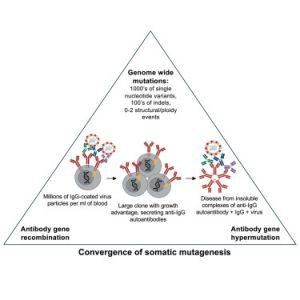Scientists have uncovered a new mechanism by which viral infections can trigger autoimmune diseases, overturning a long-standing theory (Figure 1). The study focuses on hepatitis C virus (HCV) and its role in causing cryoglobulinemic vasculitis, a severe autoimmune condition where antibodies attack blood vessels, leading to widespread organ damage. The findings pave the way for innovative approaches to predict, prevent, and treat autoimmune diseases.
HCV affects approximately 58 million people globally. The condition was traditionally thought to arise from molecular mimicry—a process where viral proteins resemble the body’s own proteins, confusing the immune system into attacking healthy tissue. However, they identified mutations in “rogue clone” B cells as the critical trigger for the autoimmune response.
The researchers studied immune cells from four patients with HCV-triggered cryoglobulinemic vasculitis. They pinpointed rogue clone B cells in high numbers, producing harmful autoantibodies. These findings highlighted a process where chronic HCV infection drives ongoing stimulation and mutation of B cells. The persistent presence of viral particles creates clusters of antibodies on the virus’s surface. These clusters continuously stimulate B cells to mutate, ultimately leading to the emergence of rogue clones responsible for cryoglobulinemic vasculitis.
The types of genetic mutations are required for the disease to develop are:
- Two Normal B Cell Mutations: These occur during standard immune cell development but are exacerbated by chronic stimulation from viral particles.
- A Chance Mutation: Associated with blood cancers, this third mutation occurs randomly over time, allowing rogue B cells to accumulate and cause autoimmune damage.
This “perfect storm” of mutations creates an environment where rogue B cells proliferate unchecked, leading to the development of the autoimmune disease.
This discovery offers new hope for millions affected by autoimmune diseases, providing a clearer understanding of their origins and guiding the development of precision treatments to address the underlying causes rather than just managing symptoms.
Journal article: Young., C., et al., 2025. A triad of somatic mutagenesis converges in self-reactive B cells to cause a virus-induced autoimmune disease, Immunity.
Summary by Stefan Botha











